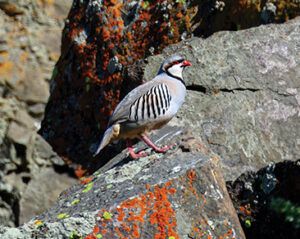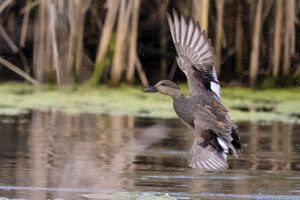Oregon’s fall outlook is uplifting for both upland birds & waterfowl.
By Jim Yuskavitch • Photos by Randy Shipley
Depending on where in Oregon you live, this past winter and spring weather seemed to range from normal to a little flaky to outright outrageous. As every bird hunter knows, the life history of both upland birds and waterfowl is tightly tied to annual weather patterns and events, and the environmental conditions they create. Most birds harvested each fall have hatched in the spring of that year, along with a small number of adults that survived the previous winter. Because upland birds are short-lived – a three-year-old is an old bird – it’s not possible to stockpile them over five or six years and end up with whole bunch of birds to hunt. That’s what makes the weather such a crucial factor for the health of bird populations and hunter success. The more adults that overwinter successfully, the more nesting activity, more broods and more birds to hunt in the fall. But only if the weather cooperates.
Here’s a brief roundup of winter, spring and summer weather conditions around Oregon, and a sample of ODFW wildlife biologists’ take on what that might mean for this year’s upland bird hunting season, along with some similar information on resident and migratory waterfowl.
 Upland Birds
Upland Birds
As Oregon goes, the North Coast – and the Coast Range in general – tends to have relatively mild, stable weather. Occasionally, there will be some unusually heavy winter snow and cold, although it typically doesn’t last long, or a cold, wet spring that can be detrimental to nesting success and brood survival. But typically, weather conditions usually don’t have extreme fluctuations as in some other parts of the state. That’s the case again this year.
“We are coming out of a good winter and decent spring,” said Tillamook-based ODFW Assistant District Wildlife Biologist Austin Reeder. “There was a lot of green-up and bugs for food for the birds, and we should have good production similar to last year.”
This part of the state has had very good forest grouse production over the last several years. Band-tailed pigeons and mountain quail are also available in this region, with populations of those birds tending to be stable over time. “Based on the weather, I would say to expect a good year for bird hunting,” says Reeder.
The situation is somewhat different 120 miles or so south and east of Tillamook on the western slope of the Cascade Mountains.
“We had a major snow and ice storm in Lane County in January that shut everything down, and extended into the rural areas,” explained Chris Yee, District Wildlife Biologist based in ODFW’s Springfield office. While the 20 inches of snowfall from that storm wasn’t impressive for the Cascade Mountains, it was subsequently covered with a hard layer of ice – conditions especially difficult for wildlife, both feathered and furred, to get at food sources.
“I’m sure we had some wildlife mortality,” said Yee.
While the west slope of the Cascades is a pretty reliable producer of forest grouse, and numbers have been good most years, snow conditions limited access for hooting surveys, making this year’s counts less thorough than normal, so hunters may have to wait to see how readily grouse will be available this season.
Yee reported that upland bird success was down a little last year, and expects similar conditions for this year. Analysis of grouse wings turned in by hunters from last year’s hunt indicated that most of the birds harvested hatched later in the nesting season and were a little smaller, possibly indicating more failed first broods. Biologists can determine when a grouse has hatched by looking at when new feathers have grown out after the birds molt. That’s one reason ODFW wants hunters to turn in their wings for analysis.
Despite all this, Yee had numerous hunters tell him that they got into lots of birds last year, so they are out there if you can find the right locations, and Yee still anticipates good upland bird hunting opportunities this fall.
Still further south, in the Roseburg area, Acting District Wildlife Biologist Nick Leonetti reports a mild winter and a favorable spring.
“The weather started out pretty good in the spring,” he noted. “We had a slow snowmelt, the rain we had in June wasn’t too extensive, and it didn’t get too cold.”
Milder conditions in the mountains also applied to valley areas, which will benefit valley quail populations, whose numbers are also boosted by high-quality habitat created by irrigated farmlands.
“The turkey broods I have been seeing so far indicate the population is doing well,” added Leonetti. He noted that he had not seen any forest grouse as of mid-July, which is unusual. But he also observed that there was good green-up at the higher elevations, which should provide an abundant food source for grouse, and hopefully result in a productive brood year.
Band-tailed pigeons and mountain quail are also species hunters may encounter in forested areas in this part of the state. Their numbers have remained fairly steady in recent years.
“Overall,” he said, “I think we’ll have a pretty good upland bird season.”
If the snow and ice storm that hit Yee’s district qualifies as outrageous, then the High Desert winter fell into the flaky category in more ways than one.
“The winter was kind of funny in Harney County,” explained Hines-based District Wildlife Biologist Lee Foster. “We had a pretty high snowpack at the high elevations. In some watersheds we had up to 160 percent of normal.” From the perspective of water storage for human, fish and wildlife use throughout the spring, summer and fall, the situation was near perfect.
High Desert upland game birds also got a break, compared to wildlife hit by the Cascades snow and ice storm. The deep snow stayed at the higher elevations, while the lower areas were snow free, or when it snowed it didn’t stick for long. This helped the birds get through the winter with minimal weather-related mortality.
But good weather conditions last fall through the winter also proved that what’s good for game birds isn’t always good for game bird hunters, and in this case chukar hunters. Lee, a chukar hunter himself, explained that an extensive green-up last fall that provided an abundant food source for chukars also made it harder for hunters to find birds as opposed to when the vegetation grows in pockets separate from each other. The same held true in the winter when snowpack concentrates birds in snow-free pockets, making them easier to locate, which wasn’t the case last winter. Foster said there were lots of chukars out there, but they were spread out over a large area, making them tough to track down, which reduced hunter success.
The summer hot spells are also a wild card, but as long as they don’t last too long it shouldn’t be a problem for the birds. Based on overall weather and resulting habitat conditions, High Desert upland birds, which include chukar, valley quail, sage grouse and some pheasant, should be relatively plentiful this season.
Up in the classic upland game bird hunting country of north-central Oregon, Heppner-based District Wildlife Biologist Steve Cherry related that, “Our winter went pretty well and we were able to successfully overwinter birds. We had a pretty decent year last year, both spring and winter conditions, so our upland bird populations are pretty healthy.” That includes chukar, Hungarian partridge, valley quail, pheasant, wild turkey and forest grouse.
In addition to good overwinter survival, spring conditions were also favorable. The hot summer weather was of some concern to Cherry. “The hot weather wasn’t good, but the chicks should be big enough by now that they are less vulnerable to overheating than if they were younger,” he said.
“Based on the broods we have been seeing, hopefully it will be a decent year,” he concluded.
 Waterfowl
Waterfowl
For waterfowl, the news is mainly good, especially for southeast Oregon, which currently has considerably wetter conditions than it has over the past several years or more.
This year’s ODFW resident duck survey found an increased population of resident ducks, with a count of about 300,000. However, about 80,000 of those were northern shovelers, many of which were migrants rather than residents, so the actual resident count may be a little lower. Nevertheless, it’s up from last year. At 70,000, mallard numbers were up from 2023, and gadwalls are also rebounding.
Overall, water conditions are good throughout the state, resulting in good production. The situation is especially bright in southeast Oregon, which has suffered under years of drought conditions that sometimes made the effort to hunt waterfowl virtually pointless. In fact, water levels dropped so low on Malheur Lake in 2022 that the North and South Waterfowl Hunting Zones were closed.
But the situation has changed. According to Brandon Reishus, ODFW Migratory Game Bird Coordinator, “Water conditions in eastern Oregon have had a significant increase in places. So expect pretty good local production.”
News from up north wasn’t available at this writing, but Reishus had been hearing that conditions in Alaska were on the dry side – a state that supplies a good number of Oregon’s migratory ducks. Another major source of Oregon’s fall flight ducks is Alberta, where conditions were tending to be on the dry side, as well. “There seems to have been a run of dry years up north,” he said, “but not too severe. I expect we will have excellent production.”
A curious trend over the past two years is a fall-off in Canada goose numbers, which is a bit unusual. Some early guesses include impacts from long-term drought conditions or avian influenza infections. However, Oregon still has plenty of resident Canada geese to go around.
